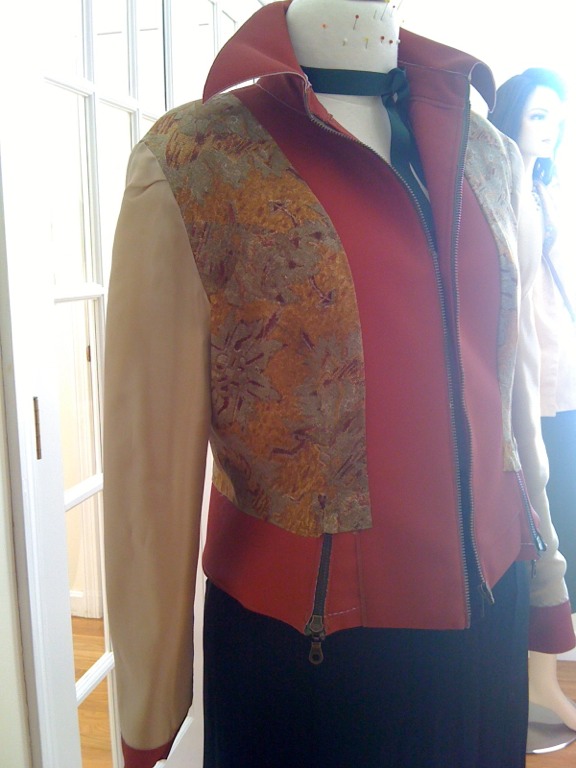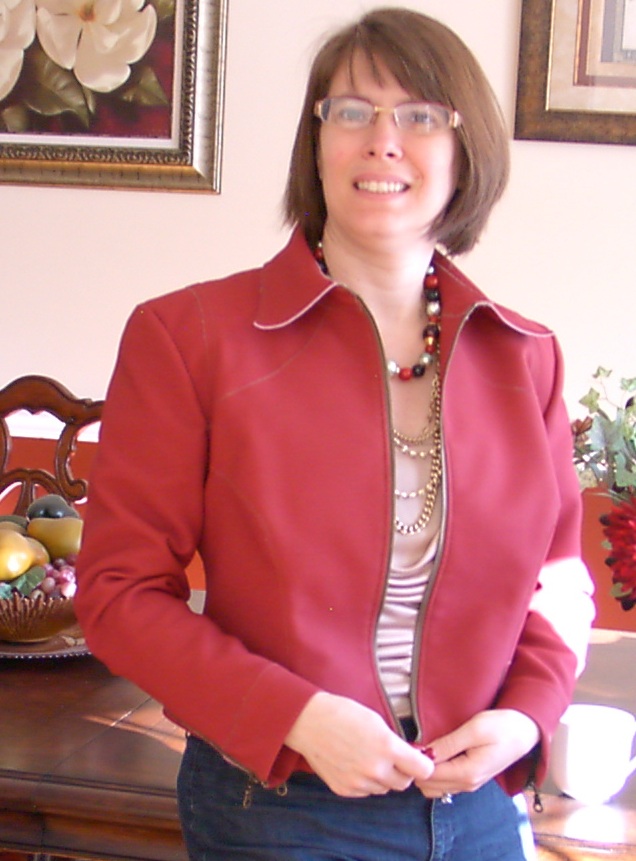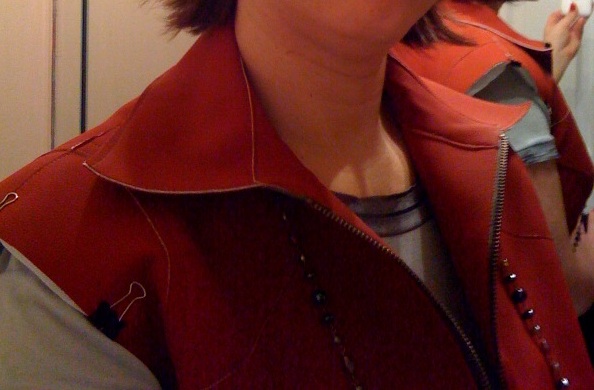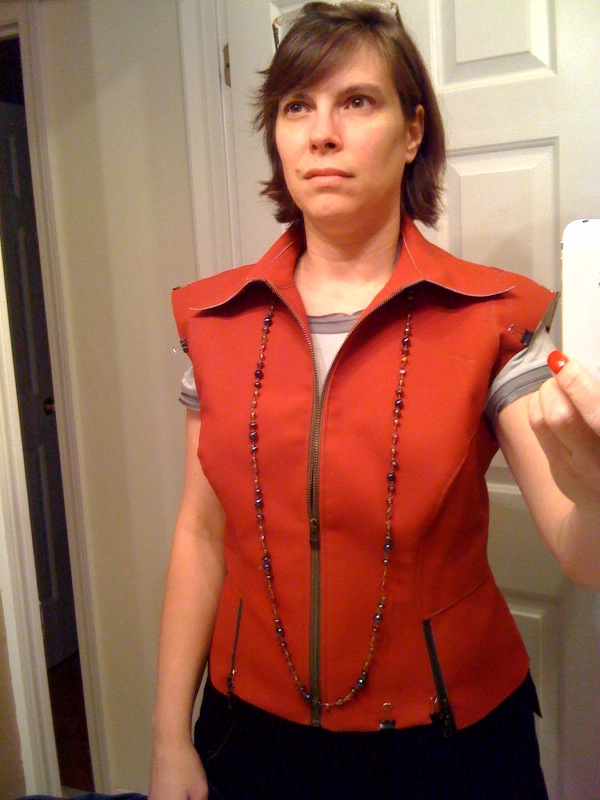Last fall, I participated in a fun sew along on line at artisanssquare.com. This was my first time sewing leather - actually it was faux leather. I have never sewn real leather.
Here is the pattern I used:
It is from BURDA Style magazine October 2009. It is a petite sized pattern. I cut size 21.
This project held a few firsts for me.
* sewing a material which will have permanent needle holes
* using fabric glue
* bagging a lining
* using lapped seams
* attaching a collar with a collar band
* pressing a fabric which will melt if touched with the iron
Some of these things posed bigger challenges than others for me.
sewing a material which will have permanent needle holes
This was especially difficult for me. I like to baste before I sew.
I also often take seams apart and resew them until I am satisfied.
Two things which helped were binder clips and IDT. IDT is a feature on
some Pfaff sewing machines, which feeds fabric from both the top and
bottom as you sew. It is like a built in walking foot. But by far,
the biggest help was using lapped seams. With lapped seams, I did not
have to sew reverse curves together in the princess seams. I simply
laid one piece over another and sewed. Well, it wasn't really that
simple. I marked all the seam lines as the pattern pieces were cut.
The pattern calls for lapped seams, which I really liked sewing.
See how the backing of the fabric is a white color? I was worried that
the white would show if I used lapped seams, so I made some test
samples and found it would not be a problem. I experimented with
thread color, stitch length and presser foot pressure, and the sample
to the right is what I set my machine up to produce. I used
contrasting thread for my samples to make it easy to judge the right
tension, and I really liked the the look of the olive color against the
red, so I went with it for the finished version. I did have some stray
white fibers peaking out of the seams in some places. I used tweezers
and sharp embroidery scissors to trim them all back.
Once I decided to use lapped seams, I had some work to do. The first
thing was to decide which seams would be lapped and which would not.
For example the sleeve back seam was sewn right sides together. Once I
decided which seams were lapped, I had to decide which was the underlap
side. Since Burda patterns do not have seam allowances, I had to add
seam allowances to all underlapped pieces as well as those wich would
be sewn right sides together. I did this by marking the pattern pieces
with dashed lines on all edges which I did NOT want seam allowances
added. When I cut the fabric, I used a rotary cutter with a gauge set
at 2cm (5/8in) to add seam allowances where I wanted them. I did not
add seam allowances to my pattern pieces. After the pattern pieces
were cut, I marked seam lines on the right side of all underlapped
seams by tracing along the edge of the pattern piece with a chalk
wheel. I did not mark the seam lines that would be sewn right sides
together. Now, I realize I could have cut all pieces with 2cm seam
allowances and trimmed them off the overlap side just before sewing,
but I think the extra legwork made my pattern pieces truer and the
sewing went quicker. The sewing was actually a joy. Having the seam
line marked on the underlapped side, I just lapped the pieces right
along that line and edge stitched them together. Additionally, I
drafted the lining from the pattern pieces, subtracting the facings,
and converting seams to darts. This was easily done since the pattern
pieces did not have seam allowances.
What did I learn?
I learned how to bag a lining. I had read how to do it a number of
times over the years, but I never did it by turning the whole assembly
through an opening in the sleeve.
What would I do differently?
I was challenged by the collar. Since I was not able to baste, I
have two rows of stitching holding the band to the jacket - One for the
inner band and then another for the outer band. Next time I sew this
type of collar on faux leather, I will use glue to hold the inner
collar in place. Then I will have one line of stitches showing where
the outer collar band is attached. Another thing I will do differently
involves the zipper seams. Again, I have double stitching in some
areas around the zippers which would be eliminated with the use of
glue. Normally, I baste and then remove those stitches, but this type
of fabric is incompatible with that method.
*Use fabric glue to baste where necessary
What I will definitely do again?
*use binder clips
*mark underlapped seam lines
*make samples to determine stitch length and presser foot pressure
*use low heat and a thick press cloth and press test samples
*draft a facing for the peplum
This leather jacket sew-along was a fun project for me. The
encouragement, advice, and praise from all of the women on artisan square was wonderful.
It was like having a bunch of friends in my sewing room with me as I went along.
Here are some pictures of my progress
The first thing I assembled was the full back.
Then the fronts with their zippers, the side seams and the shoulder seams...
...then the sleeves and the lining.


Here
I have it turned inside out to show the lining. I used a silk print I
found at the Vogue Fabrics booth at last year's Sewing and Quilting
Expo in Worcester. (I will not be able to machine wash it. I'll just
use a steamer on the inside and a damp cloth on the leather.)

If you look closely at the sleeve seam, you can see how big the opening was that I used to turn the lining to the inside.

All finished and ready to go out on the town!

But first I need to finish my coffee!
 The
The
shoulders are a little too wide, but I am happy enough with it to
actually wear it. Overall - pretty decent fit for ZERO pattern
alterations!!
Now to make a skirt....





nice post love reading it.
ReplyDeleteYou've taken my breathe away. Stunning jacket and fabulous lining. I have some leather just delivered with the intention of trousers, but I'm being tempted by jackets... thank you
ReplyDeleteNice job! I love the red! and you are very cute too! robert_john_koch@yahoo.com
ReplyDeleteThis is very nice blog because information provided here through the article and the pictures are very effective. Because sometimes words cannot explain the things that pictures can and here the words and pictures both are expressing the things in balance.
ReplyDeleteLeather vests
Lovely jacket!! Could you answer a couple of questions for me?
ReplyDeleteDo you get hot in the faux leather since it doesn't breathe? Where did you get your faux leather? thanks
Wow! I aspire to make something so cool one day! I'm still at the learning how to see a skirt without a pattern stage of my sewing but one day I'll know what all the seams and such are and make something equally chic hopefully! Thanks for the article and detail.
ReplyDeleteThis jacket looks AWESOME!! I'm about to try my hand at some embroidered black faux leather, hopefully this weekend. I hope mine turns out as well as yours.😊
ReplyDelete